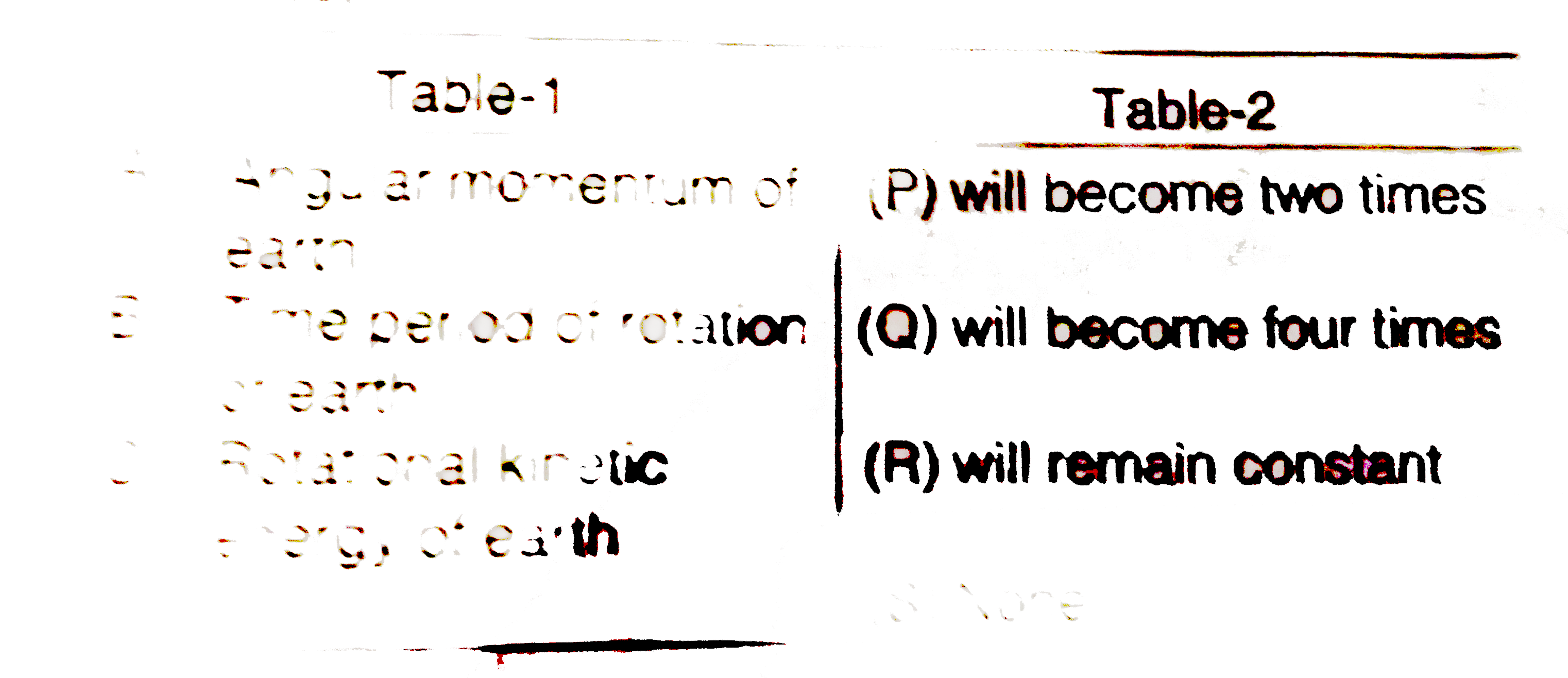If the radius of the earth contracts to half of its present value without change in its mass, what will be the new duration of the day?
To solve the problem, we need to analyze the relationship between the angular momentum of the Earth and its rotational period when the radius changes. Here’s a step-by-step breakdown of the solution:
Step 1: Understand the Initial Conditions
- Let the mass of the Earth be M.
- Let the initial radius of the Earth be R.
- The initial duration of the day (time period) is T.
Step 2: Calculate the Initial Angular Momentum
The angular momentum L1 of a solid sphere is given by:
L1=Iω
where I is the moment of inertia and ω is the angular velocity.
For a solid sphere, the moment of inertia I is:
I=25MR2
The angular velocity ω can be expressed in terms of the time period T:
ω=2πT
Thus, the initial angular momentum can be written as:
L1=25MR2⋅2πT
Step 3: Determine the New Conditions
When the radius of the Earth contracts to half its present value, the new radius R′ is:
R′=R2
Let the new time period be T′.
Step 4: Calculate the New Angular Momentum
The new moment of inertia I′ is:
I′=25M(R′)2=25M(R2)2=25M⋅R24=110MR2
The new angular velocity ω′ is:
ω′=2πT′
Thus, the new angular momentum L2 is:
L2=I′ω′=110MR2⋅2πT′
Step 5: Set the Angular Momenta Equal
Since there are no external torques acting on the Earth, the angular momentum must remain constant:
L1=L2
Substituting the expressions for L1 and L2:
25MR2⋅2πT=110MR2⋅2πT′
Step 6: Simplify the Equation
Cancel M, R2, and 2π from both sides:
25⋅1T=110⋅1T′
Cross-multiplying gives:
2⋅T′=51⋅T
Thus:
T′=52T
Step 7: Substitute the Initial Time Period
If the initial time period T is 24 hours:
T′=52⋅24=60 hours
Final Answer
The new duration of the day when the radius of the Earth contracts to half is 6 hours.
- Let the mass of the Earth be M.
- Let the initial radius of the Earth be R.
- The initial duration of the day (time period) is T.
The angular momentum L1 of a solid sphere is given by:
L1=Iω
where I is the moment of inertia and ω is the angular velocity.
I=25MR2
The angular velocity ω can be expressed in terms of the time period T:
ω=2πT
Thus, the initial angular momentum can be written as:
L1=25MR2⋅2πT
When the radius of the Earth contracts to half its present value, the new radius R′ is:
R′=R2
Let the new time period be T′.
The new moment of inertia I′ is:
I′=25M(R′)2=25M(R2)2=25M⋅R24=110MR2
The new angular velocity ω′ is:
ω′=2πT′
Thus, the new angular momentum L2 is:
L2=I′ω′=110MR2⋅2πT′
Since there are no external torques acting on the Earth, the angular momentum must remain constant:
L1=L2
Substituting the expressions for L1 and L2:
25MR2⋅2πT=110MR2⋅2πT′
Cancel M, R2, and 2π from both sides:
25⋅1T=110⋅1T′
Cross-multiplying gives:
2⋅T′=51⋅T
Thus:
T′=52T
If the initial time period T is 24 hours:
T′=52⋅24=60 hours
The new duration of the day when the radius of the Earth contracts to half is 6 hours.
Topper's Solved these Questions
- ROTATIONBOOK - DC PANDEY ENGLISHCHAPTER - ROTATIONEXERCISE - Check point 9.1
20 Videos
- ROTATIONBOOK - DC PANDEY ENGLISHCHAPTER - ROTATIONEXERCISE - Check point 9.2
20 Videos
- RAY OPTICSBOOK - DC PANDEY ENGLISHCHAPTER - RAY OPTICSEXERCISE - Integer type q.
14 Videos
- ROTATIONAL MECHANICSBOOK - DC PANDEY ENGLISHCHAPTER - ROTATIONAL MECHANICSEXERCISE - Subjective Questions
2 Videos
Similar Questions
If radius of the earth contracts to half of its present value without change in its mass, what will be the new duration of the day?
View SolutionIf radius of the earth contracts to half of its present value without change in its mass, what will be the new duration of the day?
View SolutionIf the earth, were suddenly contracted to (l/n)th of its present radius without change in its mass, then what will be the effect on the duration of the day.
View SolutionIf earth suddenly contracts to half of its present radius keeping its mass constant what would be the length of the day?
View SolutionIf radius of earth is reduced to half without changing its mass,

View SolutionIf the radius of earth contracts 1/n of its present day value, the length of the day will be approximately
View SolutionIf the radius of the earth becomes half of its present value (mass remaining the same ), the new length of the day would be
View SolutionAssertion : If radius of earth suddenly shrinks to half its present without changing its mass value, then the period of an earth's satellite will not change
Reason : Time period of a satellite does not upon the mass of earth.
View SolutionIf earth radius reduces to half of its present value then the time period of rotation will become:
View SolutionIf the radius of the earth suddenly decreases to 80% of its present value, the mass of the earth remaining the same, the value of the acceleration due to gravity will
View Solution
